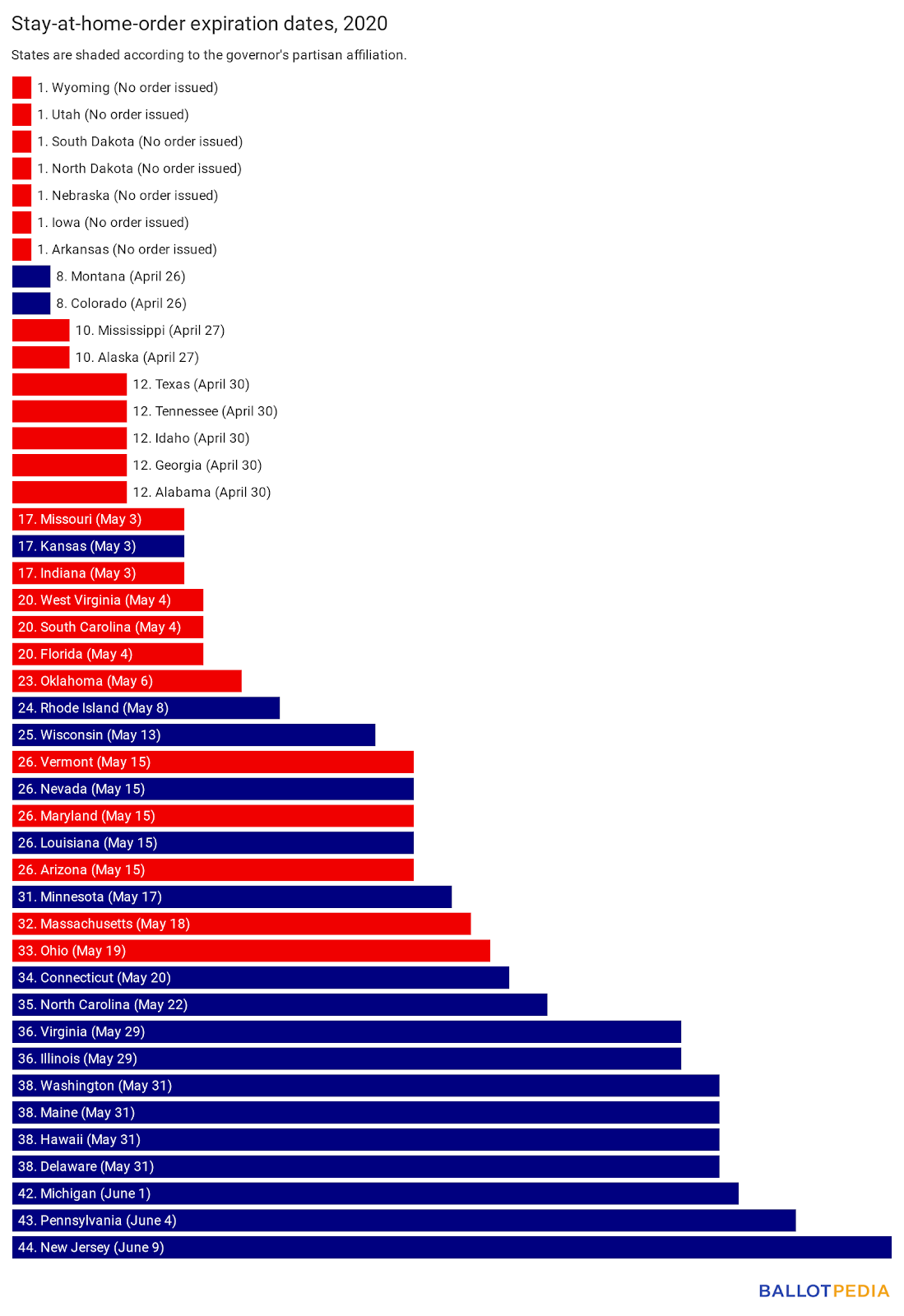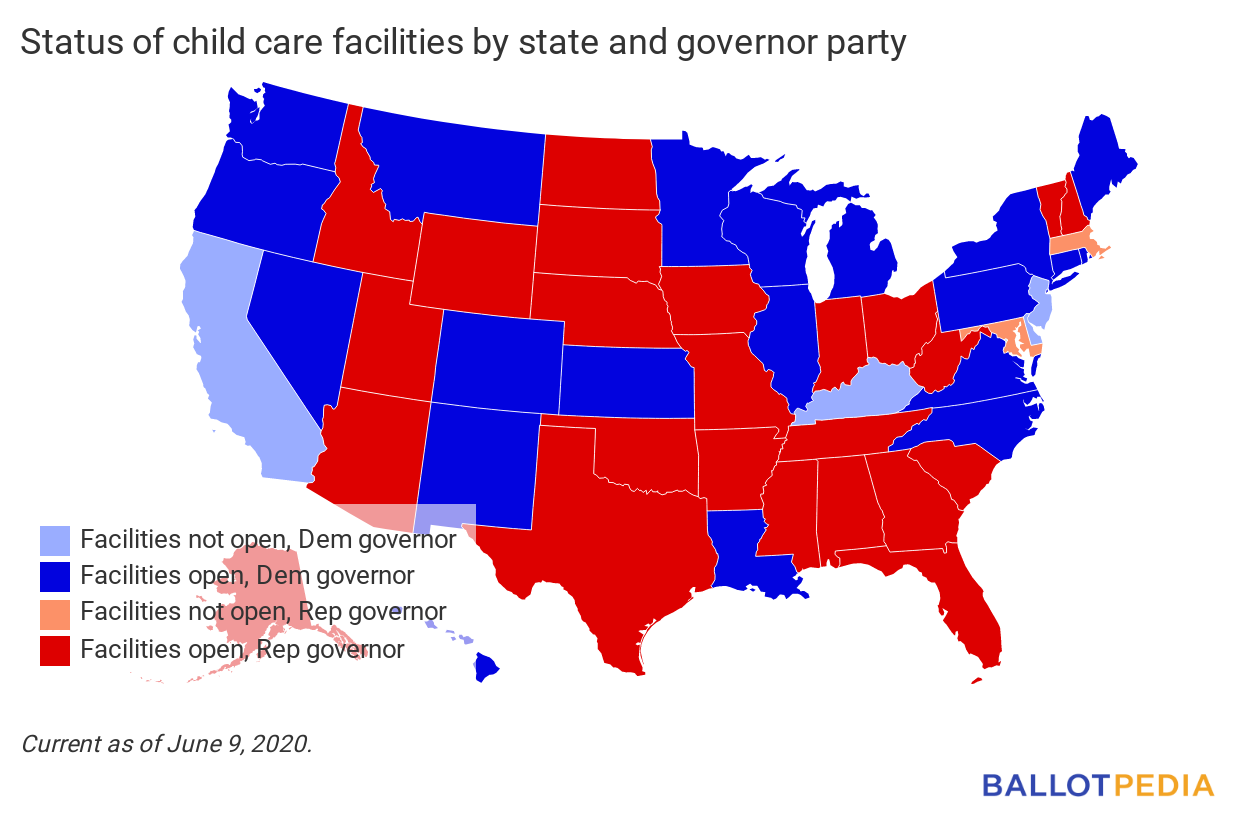|
Each day, we:
-
Track the status of reopening in all 50 states.
-
Compare the status of one industry or activity across the country.
-
Provide in-depth summaries of the latest reopening plans.
-
Give you the latest stories on other reopening plans and ideas.
Want to know what happened yesterday? Click here.
The next two days
What is reopening in the next two days? Which stay-at-home orders will expire?
June 10
-
New York (Democratic trifecta): The Long Island region is on track to become the ninth of New York’s 10 regions to enter Phase II of Gov. Andrew Cuomo’s (D) reopening plan, “NY Forward,” on June 10. The Mid-Hudson region moved into that phase on June 9. Under Phase II, the following businesses and activities are permitted to resume: offices (50% occupancy), real estate, in-store retail (50% occupancy), vehicle sales, leases and rentals, retail rental, repair and cleaning, commercial building management (50% occupancy), and salons and barbershops (50% occupancy). On June 8, Cuomo released plans for in-restaurant dining, which include operating at half capacity and tables spaced six feet apart. In-restaurant dining is slated to resume in Phase III of Cuomo’s reopening plan. Cuomo also announced that in-person special education classes could resume for the summer term.
-
Ohio (Republican trifecta): On June 10, the following businesses and activities may resume: aquariums, art galleries, country clubs, ice skating rinks, indoor family entertainment centers, indoor sports facilities, laser tag facilities, indoor movie theaters, museums, playgrounds, public recreation centers, roller skating rinks, social clubs, trampoline parks, and zoos. Gov. Mike DeWine announced that casinos, amusement parks, and water parks may reopen on June 19. On June 5, Ohio Director of Health Dr. Amy Acton revised a public health order for bars and restaurants to include wedding receptions and banquet halls. As part of the order, dance halls, billiard tables, and other games were allowed to reopen, provided social distancing and sanitation measures are followed.
June 11
Since our last edition
Have any states opened? For a continually updated article on reopening status in all 50 states, click here. For our last edition, click here.
-
California (Democratic trifecta): The California Department of Education released a 55-page guidance document for reopening schools to public instruction. The guidance includes temperature checks before entering schools or buses, face coverings for staff and students, and physical distancing requirements.
-
New Jersey (Democratic trifecta): On June 9, Gov. Phil Murphy (D) announced that he was lifting the stay-at-home order, effective immediately. Murphy’s stay at home order was issued on March 21 and did not have a set expiration date before being lifted. New Jersey was the third state to issue a stay-at-home order and the 37th to lift it. Murphy also raised the limit on indoor gatherings to 25% occupancy or up to 50 people, whichever is less. The cap on outdoor gatherings was raised from 25 people to 100 people. Murphy announced that places of worship could reopen indoor services under the new capacity limits, but parishioners must wear face coverings and be seated six feet apart. The state is expected to move into Phase 2 of Murphy’s reopening plan on June 15. On June 8, New Jersey’s Health Department issued guidelines for Summer Youth camps, including social distancing and sanitation measures. Summer youth camps are expected to reopen on July 6.
-
North Carolina (divided government): The state released guidance for reopening schools to in-person instruction. The guidance includes more frequent cleanings, a temperature check for all individuals entering buildings or buses, and physical distancing guidelines. On June 8, the North Carolina state Senate was expected to vote on House Bill 594, which would allow gyms, health clubs, and fitness centers to reopen. However, the vote was delayed until June 9, so that Senate leaders could add language that would allow bars to reopen in outdoor spaces and allow restaurants to temporarily move dining outside, despite Cooper’s veto. If passed, the bill would be sent to the state House. North Carolina is one of seven states where a three-fifths vote of both chambers is required to override a gubernatorial veto. Republicans control 29 of the 30 seats required to override a veto in the state Senate and 65 of the 72 seats required in the state House.
-
Tennessee (Republican trifecta): The Tennessee Department of Education released guidance for reopening schools in August. The document does not require Tennessee school districts to adopt any particular approach but provides suggestions and best practices for safely reopening, including requiring students and staff to wear masks and setting staggered schedules.
Update on stay-at-home orders
Forty-three states issued orders directing residents to stay home except for essential activities and the closure or curtailment of businesses each state deemed nonessential. Seven states did not.
As of June 9, stay-at-home orders have ended in 37 states. Eighteen of those states have Republican governors and 19 have Democratic governors (including Wisconsin, where the state Supreme Court invalidated the stay-at-home order).
Of the six states with active stay-at-home orders, five have Democratic governors and one has a Republican governor. They are (with expiration date):
-
New Hampshire (June 15, Republican governor)
-
New York (June 27, Democratic governor)
-
New Mexico (June 30, Democratic governor)
-
California (no set expiration date, Democratic governor)
-
Kentucky (no set expiration date, Democratic governor)
-
Oregon (no set expiration date, Democratic governor)
Here’s which stay-at-home orders have expired.

Tracking industries: Child care facilities
All 50 states are reopening in some way. Here, we give the status of one industry or activity across the states. Today’s question: in which states are child care facilities open? This does not include facilities that are only open to serving what the state defines as essential workers.



This is an in-depth summary of one of the latest reopening plans. Is there a plan you’d like us to feature? Reply to this email and let us know. Click a state below to read a previous Featured Plan.
On May 15, Gov. Phil Scott (R) announced that he was changing the statewide “Stay Home/Stay Safe” order and replacing it with a reopening initiative called “Be Smart, Stay Safe.” The initiative encouraged, but did not require, residents to stay at home.
Vermont’s stay-at-home order first went into effect March 24 and was originally scheduled to expire on April 15. On April 10, Scott extended the order through May 15. Vermont was the 19th state to end its stay-at-home order.
Scott said, “Vermonters have stepped up in a time of crisis, following guidance from the beginning to quickly slow the spread and keep our health care system from being overwhelmed. These efforts have saved hundreds and hundreds of lives and given us time to build the testing and tracing capacity we need to contain future outbreaks. The important thing to remember is that the smarter we are about our individual actions, and the more disciplined everyone can be during each step forward, the more steps we’ll be able to take to safely restart Vermont.”
Scott presented four metrics his administration was watching as the state reopened:
-
Syndromic surveillance: The percentage of visits to emergency care with either COVID-19-like illness or flu diagnosis.
-
Viral growth and reproductive rates: Case growth measured by daily, 3-day, 7-day, and effective reproductive rate.
-
Percentage of new positive tests: Percent of tests resulting in a new positive case.
-
ICU and critical care beds: Number of occupied and unoccupied medical-surgical and ICU beds.
Before May 15, Scott had signed several addendums to the stay-at-home order that authorized the authorizing limited resumption of some industries, primarily construction and manufacturing, while the stay-at-home order remained in effect.
Context
-
Between March 13 and March 24, Scott took incremental steps to close or restrict businesses and place limits on gatherings.
-
On March 24, Scott issued a stay-at-home order directing individuals to stay home unless performing critical services. The order was originally scheduled to expire on April 15. On April 10, Scott extended the order through May 15.
-
As of June 8, Vermont had reported 1,075 cases of COVID-19 and 55 deaths. Vermont’s estimated population as of July 2019 was 623,989. For every 100,000 residents, the state had 172.2 cases and 8.8 deaths.
-
Vermont has a divided government. The governor is a Republican, and Democrats have a majority of seats in the House and Senate.
Plan details
April 24
-
Scott issued Addendum 11 to Executive Order 01-20, authorizing up to five workers to perform outdoor and construction work in unoccupied structures. The order also allowed manufacturing to resume with up to five employees and in-person shopping at garden centers and greenhouses to resume with no more than 10 people including customers and staff.
May 1
May 4
May 6
-
Scott issued Addendum 13 to Executive Order 01-20, authorizing residents to leave home to participate in outdoor recreation or fitness. Social interaction was limited to 10 people or fewer. Businesses, nonprofit organizations, and government entities that supported or offered outdoor recreation, including parks, trail networks, and golf courses, were permitted to reopen subject to restrictions.
May 15
-
Scott issued Addendum 14 to Executive Order 01-20, authorizing “Be Smart, Stay Safe” to replace the statewide stay-at-home order. The order encouraged, but did not require, public mask use, and permitted lodging operations to reopen with restrictions.
May 22
May 29
-
Scott issued Addendum 16 to Executive Order 01-20, authorizing social gatherings of 25 or fewer people effective June 1. Also on that day, close contact businesses like gyms, spas, and tattoo parlors were permitted to reopen with restrictions.
June 5
-
Scott issued Addendum 17 to Executive Order 01-20, authorizing restaurants and bars to offer limited indoor dining beginning June 8, so long as occupancy is limited to 25% of the legal capacity. Addendum 17 also removed the quarantine requirement for out-of-state travelers from counties in New York and New England with 400 or fewer COVID-19 cases per million. Lodging occupancy limits were increased to 50% or 25 total guests, whichever is greater.

Additional activity
In this section, we feature examples of activities by other federal, state, and local governments and influencers relevant to recovering from the pandemic.
-
Twin Rivers Casino in Rhode Island reopened on June 8.
-
Disney released guidance for its resort hotels reopening on June 22. Face coverings must be worn by guests older than 2 except when dining or swimming. The guidelines also include increased frequency of cleaning high-traffic areas.
-
Big Horn County, Montana announced a new health order that is more restrictive than Montana’s Phase Two guidelines. It requires all employees of businesses in the county to have their temperatures checked before work and limits dine-in establishments to 50% capacity.
- Six Flags Hurricane Harbor in Oklahoma City, Oklahoma announced that the park would reopen on June 19. Safety measures include contactless infrared thermal imaging to screen guest temperatures and requiring everyone to wear face masks (except on water slides and attractions).
|
